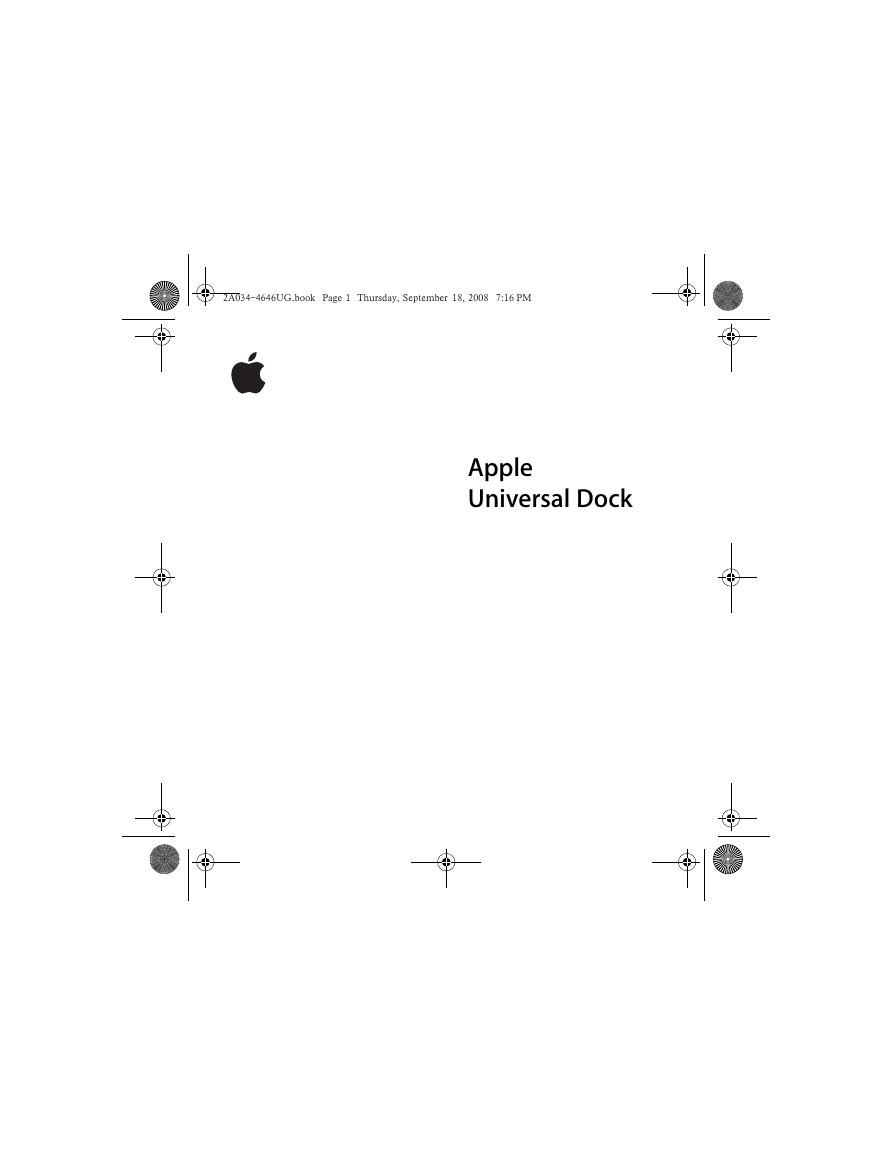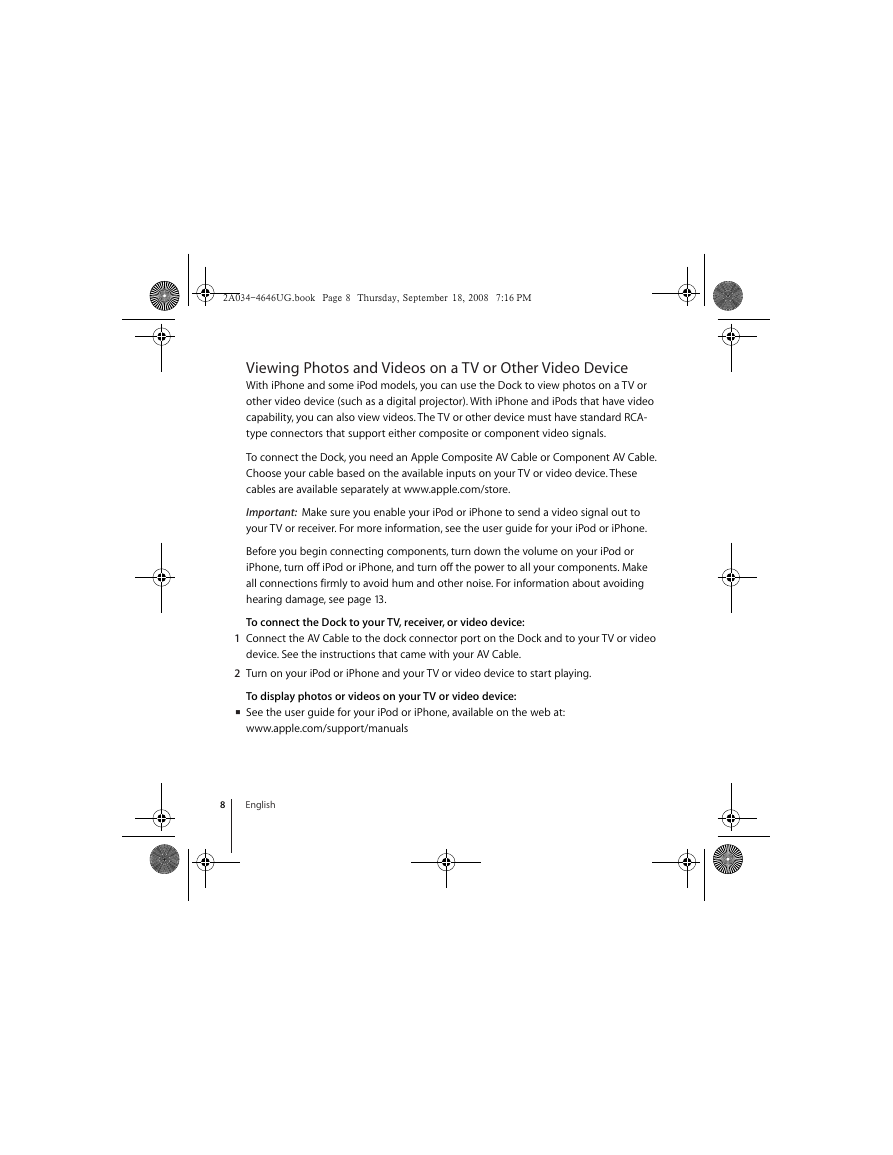)�!"�"$"$7/�>��� 2=CA � 6DKHI@=O� 5AFJA�>AH �&� ��& %��$ 2�
Apple
Universal Dock
�
)�!"�"$"$7/�>��� 2=CA 6DKHI@=O� 5AFJA�>AH �&� ��& %��$ 2�
�
)�!"�"$"$7/�>��� 2=CA ! 6DKHI@=O� 5AFJA�>AH �&� ��& %��$ 2�
Using the Apple Universal Dock
1
Congratulations on purchasing your Apple Universal Dock.
You can use this Dock with iPhone or any iPod that has a Dock connector.
Here are the things you can do with your new Dock:
Â
Connect the Dock to your computer, and then place your iPod or iPhone in the Dock
to charge the battery and sync content from iTunes (page 6).
Connect the Dock to a power outlet (using a USB Power Adapter, available
separately), and then place your iPod or iPhone in the Dock to charge the battery
(page 6).
If you have an iPhone or an iPod that displays photos, display photos on a TV or other
video device (using an Apple Composite or Component AV Cable, available
separately; page 8).
If you have an iPhone or an iPod that plays video, display videos on a TV or other
video device (using an Apple Composite or Component AV Cable, available
separately; page 8).
Connect the Dock to speakers or a stereo (using an audio cable, available separately)
to play music from your iPod or iPhone (page 9).
Control playback from a distance using the Apple Remote (page 10).
Â
Â
Â
Â
Â
English
3
�
)�!"�"$"$7/�>��� 2=CA " 6DKHI@=O� 5AFJA�>AH �&� ��& %��$ 2�
Never force a connector into a port. If the connector and port don’t join
Important:
with reasonable ease, they probably don’t match. Make sure that the connector
matches the port and that you have positioned the connector correctly in relation to
the port.
Your Universal Dock includes the following:
Universal Dock
Apple Remote
Dock adapters (8)
4
English
�
)�!"�"$"$7/�>��� 2=CA # 6DKHI@=O� 5AFJA�>AH �&� ��& %��$ 2�
Universal Dock at a Glance
Infrared (IR)
receiver
Dock connector port
Dock connector
Component
Infrared (IR) receiver
Dock connector port
Dock connector
Line out port
Line out port
What You Can Do
Control playback from a distance using the Apple Remote.
Connect the Dock to your computer or a USB Power Adapter
using the cable that came with your iPod or iPhone. Or connect
an Apple Composite or Component AV Cable to view photos or
videos on a TV or other video device (with some iPod models).
Place your iPod or iPhone in the Dock to charge the battery, sync
content from iTunes, listen to music, or view photos or videos
(with some iPod models).
Connect to external speakers or a stereo receiver using an audio
cable with a standard 3.5 millimeter stereo miniplug.
English
5
�
)�!"�"$"$7/�>��� 2=CA $ 6DKHI@=O� 5AFJA�>AH �&� ��& %��$ 2�
1
2
To use the Dock with your iPod or iPhone:
Attach the cable included with your iPod or iPhone to your computer or to a USB
Power Adapter (sold separately) that’s plugged into a power outlet, and connect the
other end to the Dock.
Choose the adapter that fits your iPod or iPhone. Your iPod or iPhone fits snugly into
the correct adapter.
The number (9–17)
shows which iPod fits
iPod nano
(3rd generation)
iPod nano
(4th generation)
iPod classic
iPod touch
iPhone
13
17
9
80GB and 120GB
1st generation
10
14
16
iPhone
12
15
160GB
2nd generation
iPhone 3G
If a dock adapter for your iPod or iPhone model isn’t included with your
Note:
Universal Dock, you can purchase one at www.apple.com/store.
6
English
�
)�!"�"$"$7/�>��� 2=CA % 6DKHI@=O� 5AFJA�>AH �&� ��& %��$ 2�
3
Insert the dock adapter into the connector well of your Dock, and then put your
iPod or iPhone in the Dock.
Dock adapter
Connector well
You can remove the dock adapter
with your fingernail by using this slot.
If the Dock is connected to your computer and iTunes is set to sync your iPod or
iPhone automatically, syncing begins as soon as you put your iPod or iPhone in the
Dock.
For more information about syncing content to your iPod or iPhone and using all of its
features, see the user guide for your iPod or iPhone.
English
7
�
)�!"�"$"$7/�>��� 2=CA & 6DKHI@=O� 5AFJA�>AH �&� ��& %��$ 2�
Viewing Photos and Videos on a TV or Other Video Device
With iPhone and some iPod models, you can use the Dock to view photos on a TV or
other video device (such as a digital projector). With iPhone and iPods that have video
capability, you can also view videos. The TV or other device must have standard RCA-
type connectors that support either composite or component video signals.
To connect the Dock, you need an Apple Composite AV Cable or Component AV Cable.
Choose your cable based on the available inputs on your TV or video device. These
cables are available separately at www.apple.com/store.
Important:
Make sure you enable your iPod or iPhone to send a video signal out to
your TV or receiver. For more information, see the user guide for your iPod or iPhone.
Before you begin connecting components, turn down the volume on your iPod or
iPhone, turn off iPod or iPhone, and turn off the power to all your components. Make
all connections firmly to avoid hum and other noise. For information about avoiding
hearing damage, see page 13.
To connect the Dock to your TV, receiver, or video device:
Connect the AV Cable to the dock connector port on the Dock and to your TV or video
device. See the instructions that came with your AV Cable.
Turn on your iPod or iPhone and your TV or video device to start playing.
To display photos or videos on your TV or video device:
See the user guide for your iPod or iPhone, available on the web at:
www.apple.com/support/manuals
1
2
m
8
English
�
















 2023年江西萍乡中考道德与法治真题及答案.doc
2023年江西萍乡中考道德与法治真题及答案.doc 2012年重庆南川中考生物真题及答案.doc
2012年重庆南川中考生物真题及答案.doc 2013年江西师范大学地理学综合及文艺理论基础考研真题.doc
2013年江西师范大学地理学综合及文艺理论基础考研真题.doc 2020年四川甘孜小升初语文真题及答案I卷.doc
2020年四川甘孜小升初语文真题及答案I卷.doc 2020年注册岩土工程师专业基础考试真题及答案.doc
2020年注册岩土工程师专业基础考试真题及答案.doc 2023-2024学年福建省厦门市九年级上学期数学月考试题及答案.doc
2023-2024学年福建省厦门市九年级上学期数学月考试题及答案.doc 2021-2022学年辽宁省沈阳市大东区九年级上学期语文期末试题及答案.doc
2021-2022学年辽宁省沈阳市大东区九年级上学期语文期末试题及答案.doc 2022-2023学年北京东城区初三第一学期物理期末试卷及答案.doc
2022-2023学年北京东城区初三第一学期物理期末试卷及答案.doc 2018上半年江西教师资格初中地理学科知识与教学能力真题及答案.doc
2018上半年江西教师资格初中地理学科知识与教学能力真题及答案.doc 2012年河北国家公务员申论考试真题及答案-省级.doc
2012年河北国家公务员申论考试真题及答案-省级.doc 2020-2021学年江苏省扬州市江都区邵樊片九年级上学期数学第一次质量检测试题及答案.doc
2020-2021学年江苏省扬州市江都区邵樊片九年级上学期数学第一次质量检测试题及答案.doc 2022下半年黑龙江教师资格证中学综合素质真题及答案.doc
2022下半年黑龙江教师资格证中学综合素质真题及答案.doc